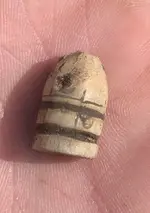Garrett Gentry
Greenie
- Joined
- Jan 22, 2020
- Messages
- 13
- Reaction score
- 10
- Golden Thread
- 0
- Location
- Northwest Arkansas
- Detector(s) used
- Garrett AT Max
- Primary Interest:
- All Treasure Hunting
Your unknown bullet appears to ba an unfired Colt Model-1874 US Army .45 Revolver cartridge bullet, missing its brass casing. See the photo and diagram below. The early version (1874) had a medium-sized cavity in the center of the bullet's base, but the later version (1880s/90s) had a solid base with just a tiny shallow dimple caused by being made in a bullet-making machine.
All of that being said... we need very-precise measurement of your unfired bullet's diameter. If it isn't extremely close to .458-inch (as specified in the 1896 Frankford Arsenal diagram), it's not a Model-1874 Colt Army Revolver bullet.

Your unknown bullet appears to ba an unfired Colt Model-1874 US Army .45 Revolver cartridge bullet, missing its brass casing. See the photo and diagram below. The early version (1874) had a medium-sized cavity in the center of the bullet's base, but the later version (1880s/90s) had a solid base with just a tiny shallow dimple caused by being made in a bullet-making machine.
All of that being said... we need very-precise measurement of your unfired bullet's diameter. If it isn't extremely close to .458-inch (as specified in the 1896 Frankford Arsenal diagram), it's not a Model-1874 Colt Army Revolver bullet.
The bullet's finder, Garrett Gentry, asked:
> The bullet has riffling marks from when it was fired. Did the colt revolver have a rifled barrel?
Yes... every Colt Revolver ever made has had rifling-grooves inside its barrel. Colonel Sam Colt preferred 6-groove rifling.
> I measured it and it seems to be .445 measuring at the bottom of the tip above the first ring.
Thank you for making the effort of providing very-precise measurement of your bullet's diameter. The measurement you got is about right. Soil acidity could've reduced your bullet's original fired diameter by .005-inch (5 thousandths-of-an-inch).
By the way... the slight line you see above your bullet's upper body-groove (not a ring) is the "crimp mark" from the rim of the bullet's brass casing.
